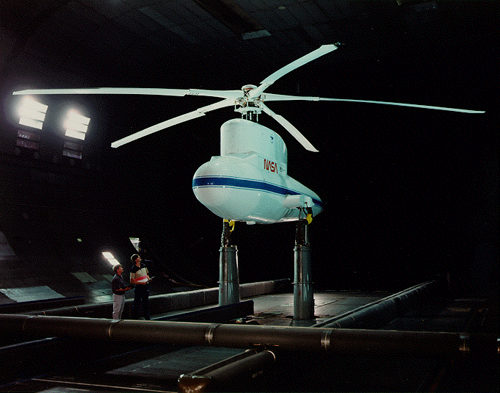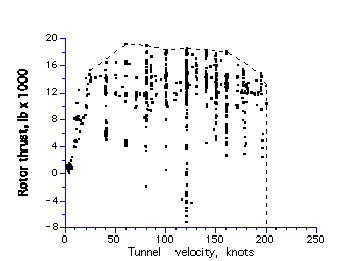Wind Tunnel Evaluation of
Sikorsky Bearingless Main Rotor
A Sikorsky Bearingless Main Rotor (SBMR) was successfully tested in the 40- by 80-Foot Wind Tunnel test section of the NASA Ames National Full-Scale Aerodynamics Complex (NFAC). This five-bladed 44-foot diameter demonstrator rotor system was designed using existing S-76 composite main rotor blades and a new five-bladed hub, employing design features similar to the rotor proposed for the RAH-66 Comanche. The rotor was first tested on the Sikorsky Main Rotor Whirl Stand, concluding in August 1991. A Memorandum of Agreement (MOA) was then signed to perform a wind tunnel test at Ames. Under the MOA, Sikorsky performed additional qualification testing and analysis to support the test program. NASA provided technical support during the pre-test effort and then tested the rotor system for a 14-week period during the summer of 1992. Figure 1 shows the Sikorsky rotor system mounted on NASA's Rotor Test Apparatus (RTA) in the 40- by 80-Foot Wind Tunnel.

Figure 1. Sikorsky bearingless rotor mounted in 40- by 80-Foot Wind Tunnel.
The primary objective of the wind tunnel test was to evaluate the SBMR in the following five areas: dynamics and stability, rotor structures and loads, handling qualities, aeroperformance and acoustics. Data from each of these areas could then be correlated against analysis to gain confidence in the analytical techniques used in the Comanche design, to improve modeling if needed and to validate design concepts already selected. A secondary objective of this test was to evaluate the effects of active controls on rotor loads, performance and acoustics.
During the test program, three new wind tunnel test methodologies were developed which proved particularly useful in meeting the SBMR test objectives. The first, dynamic calibration of the rotor balance, allowed for determination of dynamic hub loads. The second, an automated fatigue monitoring system, allowed on-line tracking of component fatigue damage. The third involved the use of frequency-response methodology for conducting handling qualities and dynamics research. Each of these methodologies provided a greatly enhanced testing capability and are applicable to future rotor tests in the NFAC.
During the course of the wind tunnel program, the rotor was tested up to thrust levels of 19,000 lb, rotor speeds to 346 RPM, tunnel velocities to 200 knots, pitching moments to RTA shaft bending limits, shaft angles to ± 10 deg, and yaw angles to ± 5 deg. Approximately 1800 data points, including 220 stability points and 460 acoustic points, were recorded during blades-on wind tunnel testing. The rotor thrust/tunnel velocity envelope achieved during the course of the program is presented in Figure 2.

Figure 2. Thrust/velocity envelope for wind tunnel test.
As a result of this testing, all significant SBMR test objectives were attained. Specific results from this program are published in three joint NASA/Sikorsky papers prepared for the 1993 American Helicopter Society National Forum.
Related Publications:
Wang, J. M. and van Aken, J. M., "Correlation of Vibratory Hub Loads for a Sikorsky Full-Scale Bearingless Main Rotor," Proceedings of the 50th Annual Forum of the American Helicopter Society, May 1994.
van Aken, J. M., Peterson, R. L. and Freedman, C. J., "Calibration Results of the NASA Ames Rotor Test Apparatus Steady/Dynamic Rotor Balance," Proceedings of the American Helicopter Society Aeromechanics Specialist Conference, San Francisco, CA, January 1994. Paper No. 4.4.
Tischler, M.B., Driscoll, J.T., Cauffman, M.G., Freedman, C.J., "Study of Bearingless Main Rotor Dynamics from Frequency-Response Wind Tunnel Test Data," Proceedings of the American Helicopter Society Aeromechanics Specialist Conference, San Francisco, CA, January 1994. Paper No. 6.3.
Wang, J. M., Norman, T. R., "Correlation of Flatwise and Chordwise Bending Moments for a Sikorsky Full-Scale Bearingless Main Rotor," Proceedings of the American Helicopter Society Aeromechanics Specialist Conference, San Francisco, CA, January 1994. Paper No. 2.1.
Norman, T. R., Cooper, C. R., Fredrickson, C. A., Herter, J. R., "Full-Scale Wind Tunnel Evaluation of the Sikorsky Five-Bladed Bearingless Main Rotor," Proceedings of the 49th Annual Forum of the American Helicopter Society, May 1993.
Wang, J., Duh, J., Fuh, J., and Kottapalli, S., "Stability of the Sikorsky S-76 Bearingless Main Rotor," Proceedings of the 49th Annual Forum of the American Helicopter Society, May 1993.
Kottapalli, S., Swanson, S., LeMasurier, P. and Wang, J., "Full Scale Higher Harmonic Control Research To Reduce Hub Loads and Noise," Proceedings of the 49th Annual Forum of the American Helicopter Society, May 1993. Download (If needed: Download Acrobat Reader)
Point of Contact:
Thomas Norman
NASA Ames Research Center
Moffett Field CA 94035-1000